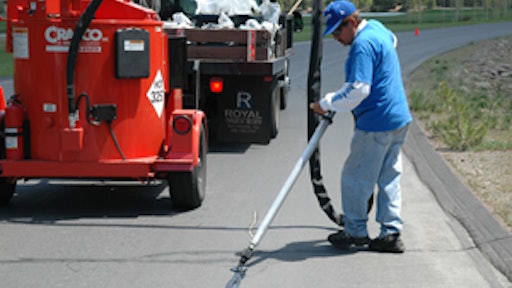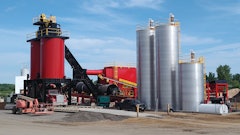
In most areas of the country, contractors are left cooped up all winter and unable to get out on the pavement. As the temperatures start to increase, so does the number of phone calls made to start repairing the damage winter left behind.
And that’s good because many contractors have spring fever when it comes to crack repair.
In cold temperatures, the pavement contracts and cracks open to the widest point. In hot temperatures, the pavement expands and closes the cracks. This is why spring is considered a good time for crack repair.
Temperatures during this time are moderate and tend not to reach the extremes of winter and summer months. However, contractors must be sure crack repair operations are done only in dry conditions. Any moisture present in the pavement or crack will prevent adhesion of the material to the crack walls, increasing the likelihood of failure.
Crack sealing is different from crack filling for several reasons. Asphalt pavement is referred to as a flexible pavement that moves horizontally due to changes in temperature and may move vertically as a result of traffic loads. Some cracks can open up to 100% of original width as the pavement temperature changes from summer to winter extremes. So generally speaking, asphalt pavement is always moving to some degree.
Crack sealing uses specialized material that will adhere to the pavement and retain the seal as the pavement moves. Crack filling uses normal material that does not have high or low temperature properties to remain flexible at low temperatures and stable at high temperatures, and when pavement movement takes place, the seal is broken. This is one example why crack sealing prevents intrusion of water and crack filling reduces intrusion of water – sealing and filling are not the same.
Here are five tips to successful crack repair, whether crack sealing or crack filling:
- Crack routing: Routing is important for two specific reasons: (a) routing cleans the crack and creates uniform and fresh edges to allow the sealant to adhere better with the pavement. This applies whether you only intend to clean the crack or separately if you decide to build a designed sealant reservoir, and (b) a designed routed reservoir filled with crack sealant has the amount of sealant needed to expand and contract with the seasonal movement of the pavement. The sealant is also at the right depth below the surface of the pavement to protect it from traffic and snowplow contact (if applicable). Routing requires an additional piece of equipment and while it adds costs to any crack sealing operation, research has shown that routed crack repairs are cost effective and last over twice as long as non-routed crack repairs.
- Crack cleaning and drying: Whether routing or not, it is essential to provide a clean, dry crack channel and remove any loose material from the crack. Cracks that are damp, that contain debris or vegetation or loose aggregate or sand, will fail because the sealant won’t stick to the crack walls. Cleaning consists of using a high-pressure dry, clean, compressed air, brushing, or vacuuming to remove debris. When there is moisture, clay or vegetation you will want to use a hot air lance – caution not to burn the crack!
- Material preparation: Contractors should be sure to follow minimum placement temperatures, minimum and maximum material heating temperatures, application life (hours material is in melter) and recommended moisture conditions prior to application.
- Material placement: Apply material when the pavement exceeds the minimum pavement application temperature which is generally 40°F. The cracks must be dry and free from ice and other contaminants. Be sure the filling or sealing operation moves at a steady pace. The melter/applicator operator should monitor the temperature and quantity of material as over- or under-heating the material can delay the entire operation.
- Blotting: Blotting protects the uncured crack treatment from tracking under traffic and is used in areas where traffic needs to travel on the material before it cures. Cement powder, talcum powder, lime, sand and limestone chips are common blotting materials. There are also proprietary detackifying products available that are designed specifically for blotting crack repair material.



























